Change happens one person at a time
Ghandi
We agree with Ghandi. And, aggregating those individuals toward common and integrated goals is anything but easy. Enterprise level change is hard and complex.
Shortcomings of Enterprise Change Management
The success rate of implementing change to achieve business objectives is dismal. For years Professor Kotter, based on his research, has been talking about the accelerating pace of change and a 70% failure rate of change in business 1. The following independently support that range of implementation failure.
- According to Boston Consulting Group, 85% of companies have undertaken a transformation during the last decade; That same research found nearly 75% of those transformations fail to improve business performance 2.
- Also, from PricewaterhouseCoopers research on M&A, “two out of three acquisitions destroy value rather than create it 3.”
- Finally, Forbes “84% of companies fail at digital transformation 4.”
It’s not like there aren’t plenty of change solutions to pick from. The massive transformation of “digital” and “agile” is bringing change management back to the forefront since falling out of grace following several waves of popular improvement methods including: reengineering of the mid-90’s, retrenchment of the late-90’s, and the batten-down-the-hatches actions as the world stumbled during the great recession. Today, the major management consulting companies actively promote their own secret sauce for approaching change management through frameworks and services. For example, from a quick internet scan:
- “The Four Building Blocks of Change,” McKinsey
- “The Change Delta,” Boston Consulting Group
- “10 Principles of Leading Change Management,” Strategy&/PricewaterhouseCoopers
- “Our Change Management Methodology,” Deloitte
- Big Change Best Path, Accenture
Why aren’t the historic and current solutions for change, while widely used, effective 5? Because they are too narrowly focused. Successfully implementing change happens by changing individual behaviors. Aligned processes and systems are critical, but most any practitioner and many researchers will tell you leadership support is the most important success factor for change- bar none 6.
So, is Organizational Change Management’s top-down view the answer? No. It it is too highly focused on leadership alignment, again necessary but not sufficient, and misses the detailed managerial-driven change necessary for the individual. Individual change management, while necessary and effective for individuals, only provides support and reinforcement from the bottom-up.
Enterprise change requires the rigor of detailed task management and integration found in Project and Program Management, but again while defining the “how” in detail through EPMOs 7, is also insufficient as a stand-alone solution. What is required to implement change in most of our businesses is an integrating approach considering Individual Change Management, Organizational Change Management, Project and Program Management, and more- all pulled together and aligned through a set of guiding principles.
There are commonalities to successful implementation. Be it post-M&A integration, digital transformation or continuous improvement, it all boils down to getting the organization and individuals within the organization to do things differently. And, we must accomplish this multi-faceted effort of leading and managing change to provide a catalyst both for the organization and for the individual to achieve targeted results.
Unpacking enterprise change management
In the following discussion, we will focus on four key interrelated and reinforcing components. And, while we are tool agnostic, for simplicity we will represent each component by the methodology we feel is most common in the businesses we work with:
- Individual Change Management (ICM)- Prosci’s ADKAR® 8
- Organizational Change Management (OCM)- Kotter’s Accelerate 9
- Project and Program Management (PPM)- Program Management Institutes’ A guide to the Project Management Body of Knowledge (PMBOK® Guide) 10
- Guiding Principles- Informed and aligned by NextForge’s “Concept of One,” principles for integration and alignment of change management activities
The representative methodologies for each of these four component’s at least touch on the others through a number of complementary, and sometimes competing, frameworks, tools and methodologies. For the sake of brevity, we will begin with a few widely referenced mental models for change, but we will remain focused on the role of each of these components (i.e., Individual Change Management, Organizational Change Management, Project-Program Management, and Guiding Principles).
Understand Some Key Foundational Mental Models of of Change
As a practitioner and student of leading and managing both organizational and individual change for more than 25 years, including 6 years with a boutique consultancy focused on and named for large-scaled strategic change, C-Change, I have yet to find a framework, or an approach, which doesn’t have its foundation in The Change Formula.
The change formula
The basis of The Change Formula is, according to Wikipedia, attributed to an Arthur D. Little
consultant in the 1960’s, David Gleicher. As I was researching change in the 1990’s I found a number of references to The Change Formula, but at that time I was unable to find attribution to a very simple framework I have used as a basis of describing and driving change and key messages of communication for more than 20 years.
- Need for Change represents dissatisfaction with the present conditions; a compelling gap between “as-is” and the “to-be.”
- Vision of the Future represents a positive picture of what is possible in the future. I recently discovered a management consultancy advocating for the “vision” to be a compelling and emotional story, similar to current thinking in brand marketing.
- Steps to Achieve the Vision represents realistic actions and activities to reach the vision; requires both resources and approach.
- Resistance to Change represents the natural and normal resistance to change, either personally or within an organization (e.g., loss of control, too much uncertainty, surprise, confused by change, loss of face, real and perceived threats, post-change issues, past resentments, perception of more work, etc.). 11 Note: Some have recently referred to this natural resistance as “immunity to change. 12”
Individuals’ stages of change
A complementary framework, helpful to understanding individual’s, and collectively an organization’s, journey through significant change is probably most renowned for its individual stages like “Uninformed Optimism” and the “Valley of Despair.”
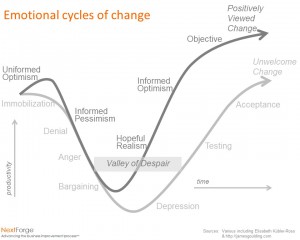 One common mental model used to understand an individual’s perspective on change is to borrow from those facing a very difficult life change- those having just received a diagnosis of terminal cancer. Elisabeth Kübler-Ross introduced the idea of “five stages of grief” in her book On Death and Dying based on her work with terminally ill patients 13. There are five common stages which can potentially be shortened if they can be catalyzed through effective therapy, or for our analogy, change leadership and management. Once an initiative is launched with catalytic leadership and management, we can expect the following in sequence:
One common mental model used to understand an individual’s perspective on change is to borrow from those facing a very difficult life change- those having just received a diagnosis of terminal cancer. Elisabeth Kübler-Ross introduced the idea of “five stages of grief” in her book On Death and Dying based on her work with terminally ill patients 13. There are five common stages which can potentially be shortened if they can be catalyzed through effective therapy, or for our analogy, change leadership and management. Once an initiative is launched with catalytic leadership and management, we can expect the following in sequence:
- Uninformed optimism
- Informed pessimism
- Hopeful realism
- Informed optimism
- Objective achievement
Many initiatives fall into the “Valley of Despair” only to lose traction and fail 14. We would suggest the high failure rate is at least in part due to not understanding or managing through these emotional stages of change.
Engaging individuals
When we think of what the individual is going through, we should also consider the “how” and “who” is most appropriate to work with an individual.
Gallup has been researching and surveying employees for more than a decade on the topic of engagement. Initially, they developed their Q12. More recently, Gallup tied employee engagement, and specific management practices covered in Q12, to business performance 15. The bottom line: what is most critical to employee engagement is the employee’s manager or supervisor. A point echoed in Prosci’s research where, for example, personal messages are preferred by individuals to be delivered by the “employee’s supervisor.” Prosci’s view of a supervisor’s role in Individual Change Management, includes “Coaching: the interactions a manager or supervisor has with direct reports to support them through the change process”.16
Let’s conclude our quick flyby of a few common foundational concepts, and get into our key components of change management by first introducing Individual Change Management through Prosci’s ADKAR®.
Component 1: Support Individual Change Management
Putting a tactical lens on change- Prosci’s ADKAR® focuses on change management from the bottom-up: the individual. ADKAR® is an acronym for a series of sequential steps individuals must go through to change: Awareness | Desire | Knowledge | Ability | Reinforcement (ADKAR®). And, while ADKAR® posits its ability to address top-down, Organizational Change Management, ADKAR’s Change Model is founded on two basic ideas 17.
- It is a person who changes, not the organization
- Successful change occurs when individual change matches the stages of organizational change
The ADKAR® Framework
In addition to five elemental phases with their associated factors and tactics, some of Prosci’s published materials, for example, as discussed in their one-page summary “Five Levers of Change Management” (key activities and plans) discuss tools to progress individuals and organizations through the five ADKAR® stages of change including:
- Communications Plan- Sends the right message to the right audience at the right time from the right sender through the right channel
- Sponsorship Roadmap- The specific actions you need from your senior leaders to sponsor the changes
- Coaching Plan- The interactions a manager or supervisor have with direct reports
- Resistance Management Plan- Steps to prevent and mitigate, but accept that it will happen (Proactive | Reactive | Preventative)
- Training Plan- Document requirements and ensure proper context
ADKAR® Approach
Prosci follows a series of gates and sequential phases of change as represented from left to right in the following graphic 18.
Prosci refers to the integration of project and change management across leadership and sponsorship as the Project Change Triangle. This is very similar to Project Management Institute’s project management “iron triangle,” noting Prosci’s addition of leadership and sponsorship roles 19.
Component 2: Support Organizational Change Management
Putting a strategic lens on change- Kotter’s focus on change leadership from the top-down- the affected organization.
Kotter separates the actions of leadership from those of management. Summarily laid out in the following table, the focus of leadership defines direction and is the engine for the change process, where management’s focus is on tools to keep change controlled.
Dual operating system
Kotter has been advocating for the management-driven hierarchy focused on reliability and efficiency to co-exist with the strategy-accelerating network focused on agility and speed 21. The traditional, box-and-wire structure continues to serve as the central organizing principle for the enterprise. The idea of the “dual operating system” is to efficiently add cognitive capacity to existing teams, while integrating hierarchical management structures with significantly faster horizontal, cross-silo networks.
The dual operating system complements traditional, hierarchical management through broader reach and through deeper, network and stakeholder involvement. By meshing traditional-hierarchical and network leadership, it supports better informed decision-making, amplifies transparency and trust, and creates a more fluid and friction-free capability for horizontal movement of issues, ideas, resources, and decision-making across the enterprise. 22
This idea of a dual operating system- focus existing hierarchical organization on today, with network(s) focused on tomorrow- is similar to recently published business model frameworks of:
- Govindarajan’s recommendation in Three Box Solution to, in Box 1, “run the core business at peak efficiency,” use Box 2 to “let go of past practices, habits, activities and attitudes,” and, with Box 3, prepare for “the non-linear future.”23
- Christensen, et al, research on business models being directional as described in MIT Sloan Management Review article’s sidebar “The Three Stages of a Business Model’s Journey” where Stage 1 creation leads to Stage 2 sustaining innovation leads to Stage 3 efficiency each with a unique operating model (e.g., Value Proposition, Resources, Processes, Profit Formula) focus mix. 24
The eight accelerators
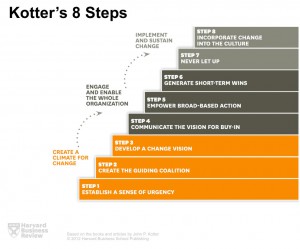 The eight accelerators are processes that enable the strategy network to function. Earlier versions of Kotter’s thinking suggested a gated sequencing, which in subsequent versions were reconsidered to be concurrently at work throughout organizational change 25.
The eight accelerators are processes that enable the strategy network to function. Earlier versions of Kotter’s thinking suggested a gated sequencing, which in subsequent versions were reconsidered to be concurrently at work throughout organizational change 25.
- Create a sense of urgency around a single big opportunity
- Build and maintain a guiding coalition
- Formulate a strategic vision and develop change initiatives designed to capitalize on the big opportunity
- Communicate the vision and the strategy to create buy-in and attract a growing “volunteer army”
- Accelerate movement toward the vision and the opportunity by ensuring that the network removes barriers
- Celebrate visible, significant short-term wins
- Never let up. Keep learning from experience. Don’t declare victory too soon.
- Institutionalize strategic change in the culture
For more information about Professor Kotter’s thinking about change management frameworks, see NextForge’s “Leading Change II- Understanding Kotter” 26
Each of Kotter’s steps and/or accelerators must be led and managed with focus on the individual, and each step’s execution, as with ADKAR®, must be resourced, planned, integrated for the appropriate stakeholder.
Support Summary: Individual Change Management and Organizational Change Management
In the following graphic, we have considered the key elements from both the Organizational Change Management framework by Kotter (left side of following figure) and the Individual Change Management framework by Prosci (right side of following figure). The Harvey balls represent significant support of the approach workstreams for various change management elements.
Source: NextForge analysis
Support activity for individual and organizational change are best if structured and integrated through common tools and principles.
Component 3: Plan and Execute Nimbly
Make key project management capabilities explicit
In order to plan, prioritize and manage the complexity of large scale change, structured program and project management is necessary to both initiatives targeted at individual change and enterprise-scale success. There are a few complementing individual and organizational change management headline activities with Project Management Institutes’ knowledge areas at the enterprise level, but they are not comprehensive. We believe in being more holistic to ensure all 10 of PMI’s knowledge areas are explicitly considered during an integrated approach. For example, the following Project Management Institute’s knowledge areas are not explicitly addressed in the ADKAR® moniker 27:
- Project Integration Management
- Project Scope-, Schedule- and Cost-Management
- Quality Management
- Human Resource Management
- Risk Management
- Procurement Management
- Stakeholder Management
Source: NextForge comparative analysis of the ADKAR® Framework (see summary above) and A Guide to Project Management Body of Knowledge (PMBOK® Guide) 5th edition.
Depending on a number of factors specific to a given project 28, we nimbly apply enough of the appropriate project management structure, informed by guiding principles, to ensure success and avoid the risk of failure. A continuum of project management support is available to us from simple, un-chartered project management to formal Executive PMO and multi-project program management.
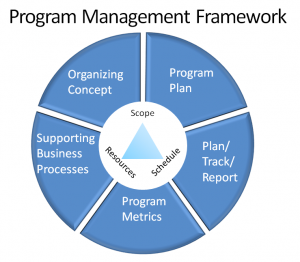 Project Management: In simplest terms, is the constant management of tradeoffs between scope, schedule and costs 29. Project Management Institute describes project management in terms of the iron triangle or the triple constraints 30.
Project Management: In simplest terms, is the constant management of tradeoffs between scope, schedule and costs 29. Project Management Institute describes project management in terms of the iron triangle or the triple constraints 30.
Program Management: wraps and supports the project management efforts on multiple projects with supporting structure including: Organizing concept, program plan, plan/track/report (scope, schedule and resources), program metrics, and supporting business processes 31.
Agile teams in enterprise project management
Because of increasing uncertainty in the business environment, the need for organizational flexibility continues to increase, and many companies are turning to agile concepts particularly for project planning and execution. We have been successfully utilizing agile concepts and progressive elaboration in our engagement approach design for more than 10 years. As a very quick summary of how agile principles can be applied to nimble business-oriented teams, here is an excerpt from our Point-of-View post on agile (scrum) concepts what we have called Swift-Teamssm .
As an engine for driving process and behavioral change into the organization, Swift-Teams provide short-interval deliverables, typically within three to four weeks. Each team’s work is sequenced with other on-going initiatives, and is managed via an integrated plan that lays out the scope and sequence of work/team modules.
The Swift-Teams are flexibly resourced from throughout the enterprise, supplemented as necessary with external experts, customers and partners. At the completion of each Swift-Team cycle precious resource assignments and individual projects may be efficiently adjusted. 32
In order to manage the overlap in the ADKAR® Model for Individual Change Management and the Accelerators for Organizational Change Management, while there are a number of ways to define guiding principles for change management, we recommend a technique we have used for more than 20 years- The Concept of One 33.
We find guiding principles focused on integration critical to early alignment of expectations and activity. Guiding principles, ensure the design and execution work is planned and scheduled in right priority and sequenced with the right level of change-resistance mitigation resourcing fully supported by leadership, management and employee.
Component 4: Integrate Relentlessly
Inform guiding principles: The Concept of One
For this discussion we acknowledge the various other principles contained in the Concepts of One as informing and complementing other guiding principles, with our focus on “one approach map”:
- One mission
- One integrated strategy (business & technology; marketing & operations)
- One decision making structure and process
- One economic model (business case)
- One map (roadmap and phase-map)
- One team (as appropriate, Swift-Teamssm)
- One organizing concept
- One set of common methods and tools
- One communications plan
- One implementation plan
- One approach map- Driving an integrated approach to change
For more on the Concept of One, see NextForge’s “Alignment- The concept of one”. 34
Integrate planning and execution of all components: “One Approach Map”
By focusing on a single overall “approach map” we can “hardwire” key change concepts into the workstreams and steps of the approach including graphically visible relationships between critically interdependent activity. We have included an approach map template below for illustration of the key moving parts (business objectives through to workstream deliverables) and general layout. The “one approach map” acts as a master plan including a roadmap, allowing work-stream project leads to utilize their own, or conform to PMO standard, project management tools. Alternately, if the complexity and risk is great enough, we can build an integrated project/program management plan inside a tool, like MS Project or Primavera, for critical-path analysis and enterprise-wide resource management.
Source: NextForge analysis
Our one approach map is a tool to integrate up to 100 key activities organized by workstream and informed by guiding principles to provide a comprehensive frame for detailed planning for executives (top-down) and managers (bottom-up) focused on overall objectives and workstream deliverables. Critically, outcomes are tied to specific actions; not only do we ensure expectation will be met if the work is done, but we also inform team members how their work contributes to the end results.
Act Through the Four Components to Achieve Results
Consider this “how to” check list
We have quickly covered broad-strokes of a number of concepts including a discussion of change management’s and change leadership’s support for individual and organizational change. As we wrap up, providing enough leadership, management, and other support to fully catalyze successful implementation, change and results- beyond the common 70% failure rate- requires consideration of all the following:
- Support Individual Change through Individual Change Management (e.g., Prosci’s ADKAR®)
- Support Organizational Change and alignment through Organizational Change Management (e.g., Kotter’s “Accelerate”)
- Plan and Execute Nimbly– Define tasks, integrate and sequence the approach through Project and Program Management (e.g., PMI’s A guide to Project Management Body of Knowledge (PMBOK® Guide))
- Integrate Relentlessly– Establish the guiding principles based on Concept of One (e.g., An approach map to “hardwire” the necessary activity, and workstreams, into the approach)
Integrating these key components for affect will increase the success rate for your transformation, your M&A post-acquisition integration, and your digital transformation by changing individual employees one at a time in synch with the necessary speed of organizational change.
One closing thought: Culture
Just as each individual employee is unique in their perspective, each company is unique in its culture- “the way we do things around here.” And, while some may add “and the why we do the things the way we do things around here,” culture must be taken into account when considering Enterprise Change. The specific methods, techniques, and combinations of tools must complement the “how we do things around here.” If you don’t customize your approach, if you don’t pick and choose what is best for your department, division, enterprise, and project, you will fall prey to the all too familiar Peter Drucker quote “Culture eats strategy for breakfast.”
When you’re finished changing, you’re finished
Benjamin Franklin
END NOTES
- See “Accelerating Change based on the work of John P. Kotter,” Harvard Business Review, [ebook] [purchased 2012] 9467TL-PPT-ENG.Microsoft PowerPoint, 82 pages
- See Schwartz, “Leaders focus too much on changing policies, and not enough on changing minds,” Harvard Business Review, June 25, 2018 [internet] [cited July 28, 2018] Available from https://hbr.org/2018/06/leaders-focus-too-much-on-changing-policies-and-not-enough-on-changing-minds
- See PricewaterhouseCoopers’ (PWC’s) M&A Integration Survey 2017, “Success factors in post-merger integration,” [internet] [cited July 28, 2018] Available from https://news.pwc.ch/wp-content/uploads/2017/06/success-factors-in-post-merger-integration_2017_web.pdf
- See Bruce Rogers’ article of the same name “Why 84% of companies fail at digital transformation,” where, based on Forrester Research’s research by Michael Gale “not enough people within the organization are aware of the challenges.” Further, Gale posits “if you don’t spend time changing people’s behaviors, you don’t spend time changing culture and how people make decisions, all of this falls flat.” And finally, “I think a large part of that 84 percent that fail it’s because they’re not prepared to change behavior.” Rogers, “Why 84% of companies fail at digital transformation,” Forbes, January 7, 2016, [internet] [cited July 28, 2018] Available from https://www.forbes.com/sites/brucerogers/2016/01/07/why-84-of-companies-fail-at-digital-transformation/#22f6ab86397b
- “Change Management Programs” rank No. 6 of top 25 management tools in broad use (“significantly above the overall mean”), yet are not meeting expectations/needs (“significantly below the overall mean” for satisfaction); See most recent (2017) Bain survey by Rigby & Bilodeau, “Management Tools & Trends, Five key trends emerged from Bain’s survey of 1,268 managers,” Bain and Company, April 05, 2018 [internet] [cited August 8, 2018] Available from https://www.bain.com/insights/management-tools-and-trends-2017/
- “The keys to successful change, according to the American Management Association survey, are first and foremost leadership” and numerically ranked first in table 1; See Gill, “Change management – or change leadership?” Journal of Change Management, May 2003 [internet] [cited August 7, 2018] Available from http://two.nitbj.com.cn/nit/content/references/Gill.pdf; Cited 527 times on Google Scholar. Also, as a tactical example, see the increasing use of leadership (CEO’s office) sponsorship throughout the organization’s digital maturity in Kane, “Is the right group leading your digital initiatives?” MIT Sloan Management Review, August 3, 2018 [internet] [cited August 7, 2018] Available from https://sloanreview.mit.edu/article/is-the-right-group-leading-your-digital-initiatives/
- See EPMO treatment in “Enterprise project management,” Wikipedia, [internet] [cited August 7, 2018] Available at https://en.wikipedia.org/wiki/Enterprise_project_management
- See Hiatt, ADKAR®, A model for change in business, government and our community, Loveland, CO: Prosci (2006)
- See Kotter, Accelerate, Boston, MA: Harvard Business School Press (2014)
- See A Guide to the Project Management Body of Knowledge (PMBOK® Guide), Newton Square, PA: Project Management Institute (2013)
- For more detailed treatment of the change equation and the source of definitions presented here on elements of the change equation, see Reeder, “The Change Formula,” Nextforge, [internet] [cited July 28, 2018] Available from https://nextforge.com/?p=167
- See discussion and reference to work by psychologists Lahey and Kegan in Schwartz, “Leaders Focus Too Much on Changing Policies, and Not Enough on Changing Minds,” Harvard Business Review, June 25, 2018, [internet] [cited 7.28.2018] Available from https://hbr.org/2018/06/leaders-focus-too-much-on-changing-policies-and-not-enough-on-changing-minds
- See “Kübler-Ross model”, Wikipedia [internet] [cited June 17, 2013] Available from http://en.wikipedia.org/wiki/K%C3%BCbler-Ross_model. Also see NextForge’s “Change Leadership- Traversing the emotional cycles of change,” [internet] [cited July 28, 2018] Available from https://nextforge.com/?p=2115
- “The 8-Step Process for Leading Change”, Kotter International [internet] [cited June 17, 2013] Available from http://www.kotterinternational.com/our-principles/changesteps/changesteps. Also see “Kanter’s Law” where Rosabeth Moss Kanter, also an HBS professor who studies change, suggests “Everything looks like failure in the middle”, from Kanter, “Change is hardest in the middle,” Harvard Business Review, August 12, 2009, [internet] [cited July 31, 2018] Available from https://hbr.org/2009/08/change-is-hardest-in-the-middl
- For more information on Gallup’s Q12, see Wagner and Harter, 12 The elements of Great Managing, NY, NY: Gallup Press (2006). At the time of the printing of this New York Times best seller, responses and meta-data on business performance were based on more than 10MM employee surveys.
- See slides provided with Prosci’s Webinar “How to drive adoption with Five Strategic Change Plans,” copyrighted 2014, [internet] [cited 7.9.2018] Available from https://portal.prosci.com
- See “What is the ADKAR Model for change?” (Part 1 of 2), a 3M46 Video, Prosci [internet] [cited July 28, 2018] Available from https://naijafy.com/video/f_FY8L5xJLE
- “ADKAR® Change Management Model Overview,” Prosci [internet] [cited June 22, 2018] Available from www.prosci.com/adkar/adkar-model
- See “How to Leverage the Project Change TriangleTM (PCT) Model,” Prosci [internet] [cited July 12, 2018] Slide-deck available at https://portal.prosci.com/resources/view/111
- See Kotter, “Change Management vs. Change Leadership- What’s the difference?” Forbes, July 12, 2011, [internet] [cited June 22, 2018] Available at www.forbes.com/kohnkotter/2011/07/12/change-management-vs-change-leadership-whats-the-difference
- See Kotter’s, Accelerate: building strategic agility for a faster moving world, Harvard Business Review Press, Boston, MA (2014), p 37 and the typical lifecycle from network to hierarchy p 70. Also consider the parallel concept based on recent research by Christensen, “The Hard Truth About Business Model Innovation,” MIT Sloan Management Review, Fall 2016, where Christensen, et al’s research demonstrates new business model’s necessary separation from the sponsoring organization, progressing along an arc from new market formation (creation), to process formation in response to recurrent tasks (sustaining innovation), to modular structure formation, and finally to investors’ demand return of capital (efficiency).
- Sourced from an unpublished working paper Everson and Reeder, “Enhanced Enterprise Execution, Catalyzed by a Dynamic Social Network,” Adjuvi, April 2017.
- See summary table 1-1, p 4, of The Three Box Solution, A strategy for leading innovation, Harvard Business Review Press, Boston, MA (2016)
- See Christensen, et al, “The Hard Truth About Business Model Innovation,” MIT Sloan Management Review, Fall 2016. Specifically, see side bar “The Three Stages of a Business Model’s Journey” of different focus of each stage from creation to sustaining innovation to efficiency, where today’s organizational efficiency focus (through for example hierarchy) cannot support tomorrow’s initial business model’s flexible development needs. Also see Reeder, “What You Need to Know About Business Models,” NextForge, [internet] [cited August 8, 2018] Available from https://nextforge.com/?p=2345
- See overview discussion of Kotter on leadership and change in Reeder, “Change Leadership ll, Understanding Kotter,” NextForge, [internet] [cited July 28, 2018] Available from https://nextforge.com/?p=1587; Kotter’s 8 Step Graphic is from “Accelerating Change based on the work of John P. Kotter,” Harvard Business Review, [ebook] [purchased 2012] 9467TL-PPT-ENG.Microsoft PowerPoint, 82 pages.
- Reeder, “Change Leadership II- Understanding Kotter,” NextForge, [internet] [cited August 8, 2018] Available from https://nextforge.com/?p=1587
- NextForge gap analysis of those 10 Project Management Institute knowledge not explicitly included in the ADKAR® framework. See A Guide to Project Management Body of Knowledge (PBOK® Guide) 5th edition, Newton Square, PA: Project Management Institute (2013)
- For example DICE® is an acronym, and elements of a patented equation, for determining the certainty of success including (D)uration of project, (I)ntergrity of the team, organizational (C)ommitment to change, and (E)ffort required to change “DICE- a tool for executional certainty,” The Boston Consulting Group [internet] [cited August 7, 2018] Available from http://dice.bcg.com/index.html#intro
- See Reeder, “Defining project management,” NextForge [internet] [cited July 28, 2018] Available from https://nextforge.com/?p=155
- See Lee, “Managing the challenges of the triple constraints,” Project Management Institute [internet] [cited July 28, 2018] Available from https://www.pmi.org/learning/library/managing-challenges-triple-constraints-6884
- See Reeder, “Defining program management,” NextForge [internet] [cited July 28, 2018] Available from https://nextforge.com/?p=153
- Reeder, “Swift Teams,” NextForge, [internet] [cited August 8, 2018] Available from https://nextforge.com/?p=88
- Reeder, “Alignment- The Concept of One,” NextForge, [internet] [cited August 8, 2018] Available from https://nextforge.com/?p=773
- Reeder, “Alignment- The Concept of One,” NextForge, [internet] [cited August 8, 2018] Available from https://nextforge.com/?p=773

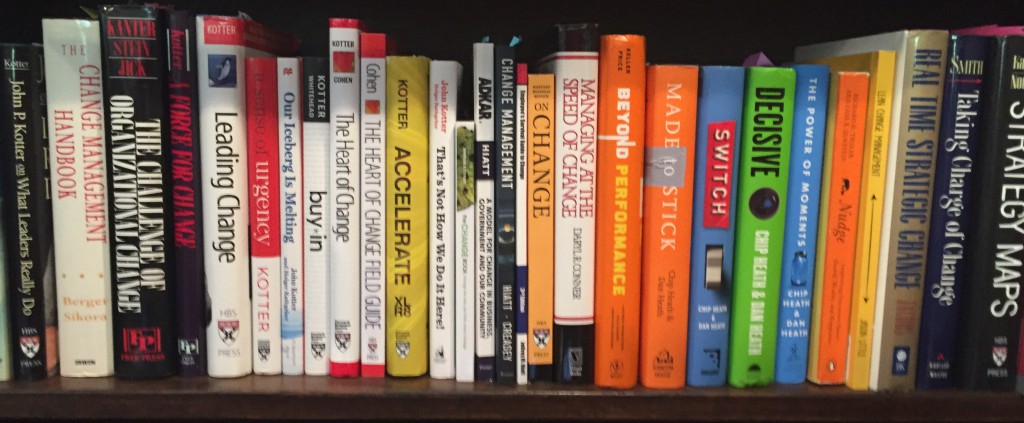
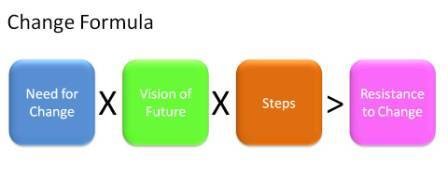
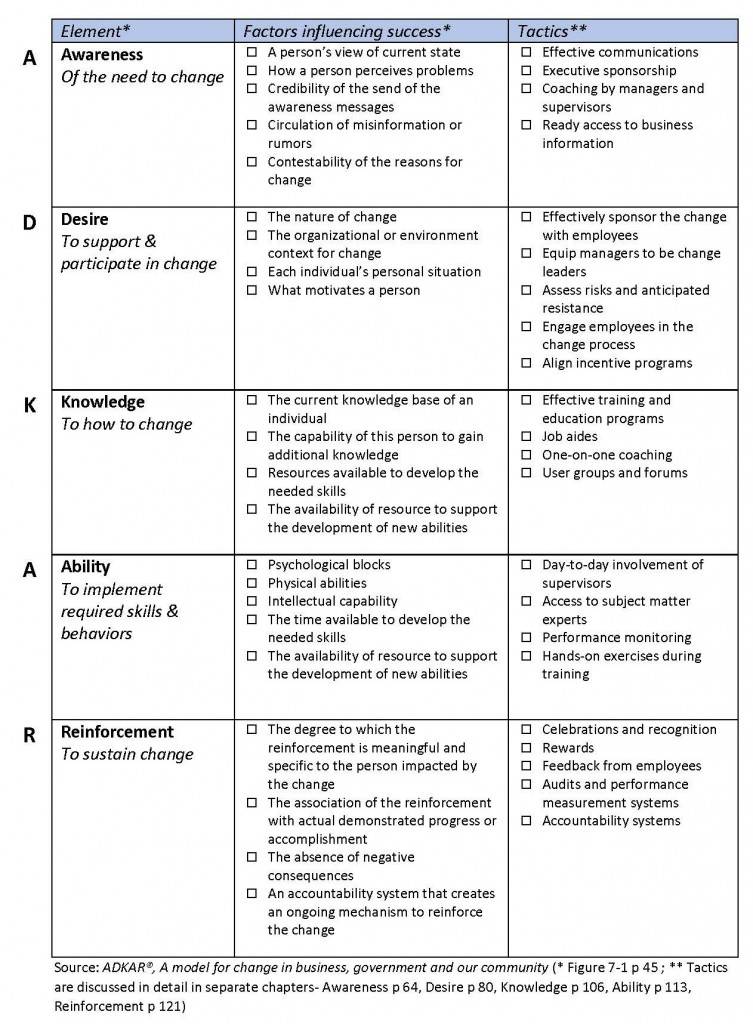


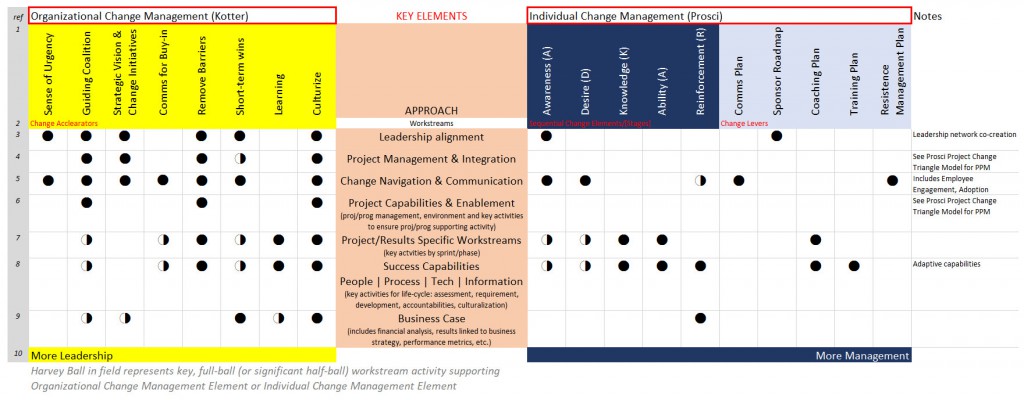
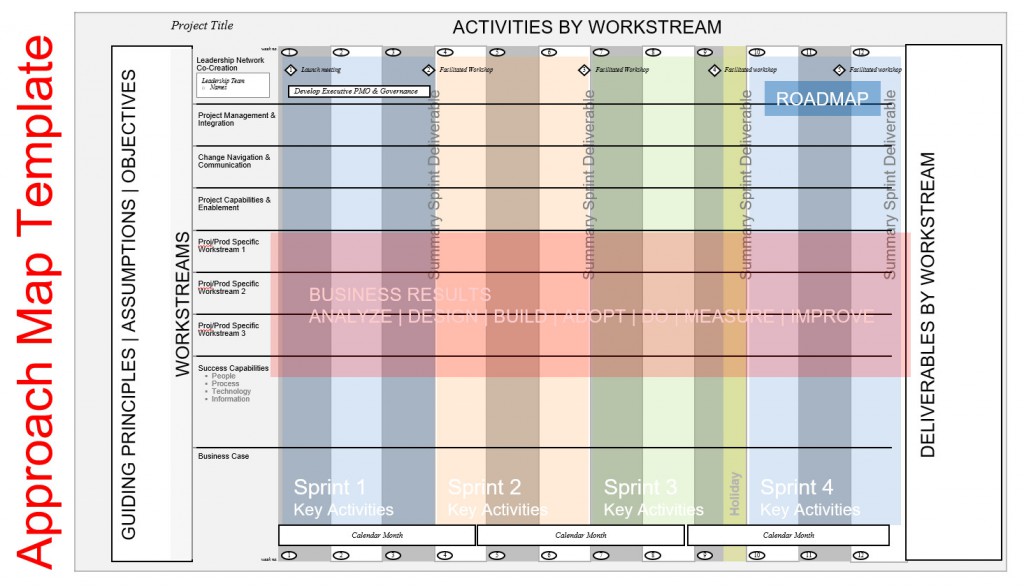

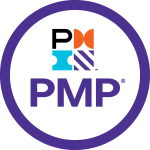

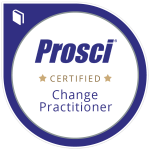

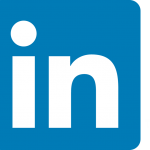

2 Responses
NOTE FROM THE AUTHOR:
See our summary overview of this post on LinkedIn…
https://www.linkedin.com/pulse/why-change-management-catalyzes-results-tom-reeder/
Join in on the conversation. Let us know what you think!